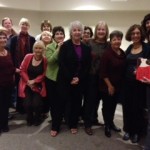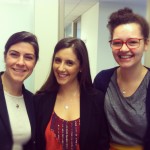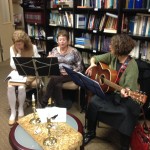 Last weekend, I led two Jewish services, one on Friday night at my synagogue and the second on Saturday morning for my Renewal group. I led prayers – singing and playing guitar and drum – and shared a teaching about the Torah reading, the one where the Israelites are fleeing Egypt, the sea miraculously parts, and, after they cross the sea, they burst into song.
Last weekend, I led two Jewish services, one on Friday night at my synagogue and the second on Saturday morning for my Renewal group. I led prayers – singing and playing guitar and drum – and shared a teaching about the Torah reading, the one where the Israelites are fleeing Egypt, the sea miraculously parts, and, after they cross the sea, they burst into song.
As the Talking Heads put it in “Once in a Lifetime” – and with the same tone of disbelief – how did I get here? How, after a very secular upbringing and literally decades of feeling disconnected from Judaism, did I end up leading prayers?
Although the term tikkun olam – repairing the world – wasn’t yet in vogue, the Judaism I experienced growing up in the 1950s and 60s was tikkun olam Judaism: committed to social justice and leading an ethical life. I was proud that the rabbi of our Reform synagogue in Milwaukee – Dudley Weinberg of Temple Emanu-El B’ne Jeshurun – was prominent in the civil rights movement. A high point of my teens was a post-confirmation class with guest speakers including anti- war protestors, black activists, etc.; it led to a group of us petitioning for Black Studies at our very-white suburban high school. (To be honest, the speaker who made the most indelible impression on my 17-year-old self was a poet who advocated free love!)
I continued trying to repair the world when I went to college. I marched against the Viet Nam War. I wrote for progressive newspapers. I embraced the women’s movement. But when it came to Jewish practice, my parents – like Elaine in The Tin Horse – were of the generation that yearned to be American like their neighbors. We celebrated Hanukkah and Passover, and I did get sent to religious school, where I learned the Genesis and Exodus stories and got a heavy dose of Jewish Heroes, people who’d achieved in science or the arts or – less often but cooler – sports, who could give us some muscle-flexing Jewish pride.
But I didn’t have a Bat Mitzvah, nor did either of my brothers have Bar Mitzvahs. Jewish rituals weren’t a significant part of my childhood. And, in my twenties and thirties, the same tikkun olam principles that drew me toward feminism pushed me away from the patriarchal Jewish narrative and traditions. Plus, my husband is a lapsed Catholic, and we don’t have kids, so we had no concern about providing a religious-ethical education. Once every few years, I’d feel a vague tug and try a synagogue … but there was always something that reminded me of why I felt alienated.
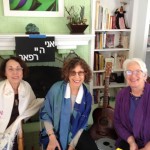
What rekindled a sense of connection was a Bat Mitzvah … on my husband’s side of the family. Right, that’s my lapsed-Catholic husband, Jack Cassidy. Jack’s sister also has a Jewish spouse, and in the early 90s, their daughter Rachel had a Bat Mitzvah. Their synagogue in Seattle, Eitz Or, had one of the first women rabbis, Vicki Hollander, and there was a moment during the Bat Mitzvah when the four people standing on the bimah (podium) were Rabbi Vicki, Rachel, and Rachel’s grandmother and aunt on her dad’s side. All women! For the first time in years, I was in a synagogue … and I felt at home.
Shortly after that, I started to plan a new novel in my mystery series. My brother David lives in Tel Aviv (he teaches statistics at Tel Aviv University), and I decided to give my sleuth, a San Diego radio reporter, a mystery to solve in Israel. I could visit David and write it off! Figuring out where in Israel to set the story, I had the thought, “Isn’t some branch of Judaism associated with the town of Safed? And it’s in the Galilee, it looks pretty.” I had no idea that Safed was a centuries-old center for Kabbalah, Jewish mysticism. I wasn’t even aware that Judaism had mystics. (This was before Madonna and other celebrities became devotees of the Kabbalah Center.) But, as research for the book (“Death in a City of Mystics”), I started to read and study. And I was captivated.
Two books spoke to me deeply: Rabbi Lawrence Kushner’s “God was in this Place & I, i did not know” and Judith Plaskow’s “Standing Again at Sinai.” Kushner’s book is a multi-faceted take on Jacob’s dream of a ladder with angels going up and down, and it made me aware that Jewish texts are rich with psychological resonance and open to a multiplicity of interpretations. Reading “Standing Again at Sinai,” a classic of Jewish feminism, I found that during the years when I’d stayed away, there were women who so valued their connection to Judaism that they were insisting on carving out a larger place for us. (It’s a struggle that continues – do you know about the amazing Women of the Wall in Jerusalem?)
I learned about Kabbalah from a great set of tapes (now on CD) by Rabbi David A. Cooper, to which I listened in the car. I was driving through the hills east of La Jolla when I heard the teaching that every blade of grass has an angel whispering to it, “Grow! Grow!” Now, any time I’m on that stretch of I-5, I still hear it: “Grow!” Not that I really believe that. But neither do I disbelieve it. I think what touched me was that the religion I’d experienced as dry and intellectual also had room for this poetic flight of imagination.
Jack and I went synagogue-shopping and found a Reconstructionist congregation, Dor Hadash, and also a Jewish Renewal group, Shir Ha Yam. I’ve linked to sites that explain Reconstructionism and Renewal far better than I could. But briefly, both are progressive, with women in leadership roles. At Dor Hadash, I’ve enjoyed being part of a welcoming, intellectually stimulating community, jamming with a wonderful music group … and getting the opportunity to have my Bat Mitzvah when I was 49! In Renewal, I love the Jubu (Jewish-Buddhist) practices of chanting and meditation and. And, at Renewal retreats, I’ve explored creative ways to dive into texts – I’ve done bibliodrama with Peter Pitzele and Arthur Strimling, and practiced Storahtelling with Caryn Aviv.
In both communities, I’ve discovered that Jewish music speaks to my heart, especially music by contemporary women composers: Rabbi Shefa Gold’s chants, Cantor Linda Hirschhorn’s multi-part a capella songs, Debbie Friedman’s soulful tunes. And – back to, how did I get here? – I’ve found that my love for music, plus the ability to carry a tune and play guitar a little, has led to my being a lay service leader.
I have also become a trop geek. Trop are the melodies used to chant sacred texts, and there are different trops depending on the text. For my Bat Mitzvah, I learned Torah and Haftarah trop. I’ve since acquired a bit of Song of Songs (the melody does sound like a love song). Using the Torah trop for the High Holy Days, I’ve learned to chant the Akeda, the story of the binding and near-sacrifice of Abraham’s son, Isaac, and I’ve grappled with that wrenching story … and that gets me into the new novel I’m writing, in which one character is studying to be a cantor and will chant the Akeda for the first time.
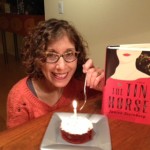 It’s hard to believe, but it’s one year since “The Tin Horse” was published – January 29, 2013! Year 1 has been an amazing ride. A few highlights …
It’s hard to believe, but it’s one year since “The Tin Horse” was published – January 29, 2013! Year 1 has been an amazing ride. A few highlights …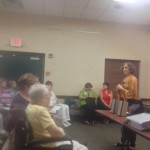 * In August, I spoke to a Hadassah group in Madison, Wisconsin, and my mom was able to attend! (She’s in the yellow shirt in the foreground of the picture.)
* In August, I spoke to a Hadassah group in Madison, Wisconsin, and my mom was able to attend! (She’s in the yellow shirt in the foreground of the picture.)